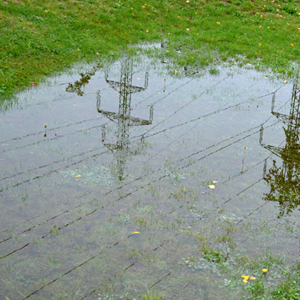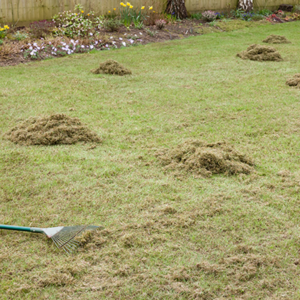In just a month or so, the ground will begin to thaw, the days will get longer, and the grass will start greening up. If you’d like to help that greening up process along, there’s a treatment you can have done. Spring aeration is a great way to loosen up hardened soil and increase the flow of water and nutrients into your soil – before the peak heat of summer comes. Keep reading to learn more about this beneficial process and how to tell if your lawn needs a helping hand.
Why Aeration Is Important
You might have heard it referred to as traditional aeration or core aeration. They’re the same, and this lawn treatment is such a straightforward but effective means to improve your lawn. Using a tool known as a lawn aerator, your Quality Cut team member will punch thousands of tiny holes into your yard and pull out plugs of soil. These plugs will break down on the lawn surface and return nutrients to the earth. So why do we punch holes in your lawn?
For one thing, it breaks up hard ground that makes it difficult or impossible for grass to grow properly. For another thing, these holes allow oxygen, water, sunlight, and nutrients to penetrate deep into the earth where the grassroots can absorb it. Lastly, aeration alleviates the impact of thatch build-up in your lawn.
What Does Soil Compaction Mean
You’ve probably noticed how loose and fluffy a fresh bag of topsoil is. It’s that way for a reason. Plants need to push through the earth and expand their root system. The soil also needs to be loose enough that water and fertilizer deposited on the surface will sift through easily and reach the root zone. Over time, the earth will compress and become hard like a block of cement. When nutrients, water, light, and air can’t move through the soil, it hinders the grassroots’ growth, and the lawn will start to have diminished color and wilting. The only way to combat this problem is with an aeration treatment.
How To Tell If Your Soil Is Compacted
Water Issues
If your lawn turns into a lake after rain, it could be that your soil is compacted, and the water cannot flow through it freely. This is especially true in spring. After all that ice and snow pressing down on the earth, your lawn is more likely to experience compacted soil at this time. In addition to water puddling, you may also notice that water runs off the surface of your lawn as if it’s water repellant – particularly if you have a yard with an incline. Once again, too much compacted soil is to blame.
Poor Grass Health
As we discussed before, compacted soil deprives grass of the air, water, sunlight, and nutrients it needs to grow tall and strong. So if your grass doesn’t seem to be greening up like usual this spring, the soil below it may be compacted. Note: there are many reasons why grass doesn’t grow, so if you’re not experiencing any of the other symptoms in this blog, it might be another problem. If you want to be sure that soil compaction is the problem, keep reading and follow the instructions in the next step.
The Screwdriver Test
The best way to determine whether or not you have compacted soil is with the screwdriver test. Simply put, all you need to do is try and jab a screwdriver into the ground. If you’re unable to do so, you’ve got compacted soil.
Thatch Build-up
Another common issue with landscaping is thatch build-up. Thatch is a naturally occurring material made of dead organic debris that builds up over time in our lands. Generally, it comprises dead grass clippings, but it could also include dead leaves, petals, and small twigs. If you’ve ever noticed a straw-like substance when raking your lawn – that’s thatch. Having a bit of thatch on your yard is a good thing. It helps smother broadleaf weeds before they have a chance to germinate, and it helps trap moisture during the driest parts of the winter and summer. But as the old saying goes: all things in moderation. When thatch becomes too thick, it will smother the weeds and the grass along with it. A de-thatching treatment is something you can do to alleviate this problem, but aeration will help too – in addition to breaking up compacted soil. In short: aeration will kill two birds with one stone.
Why Aerate In The Spring
Anything you can do to pave the way for your grass to grow more easily is always a good idea. With that in mind, having aeration done in spring will clear out the obstacles of thatch build-up and soil compaction. And if your ground was compacted for a long time, spring is an excellent time to repair the damage. After the earth’s been opened up from aeration, Quality Cut can overseed your lawn with fresh grass seed, if you’d like. The aeration holes make it easier for the new seed to nestle into the ground rather than sit atop it. We only use the highest quality grass seed, so it germinates quickly and blends seamlessly with your existing lawn.
Get Professional Lawn Care From Quality Cut Lawn Service
If your lawn could use an aeration treatment this spring, leave it to the professionals at Quality Cut Lawn Service. We’re pleased to offer lawn care and landscaping to customers near Newark, Delaware. Aeration is one of the most beneficial things you can do for your lawn this spring. We’re happy to add it to your existing lawn care program or as a stand-alone treatment for yards that need some extra TLC. To learn more or schedule an appointment, give us a call at 302-420-7597, or you can reach us through the contact form.
And don’t forget, you can learn more about what we do and how to maintain your yard by checking out our blog page.
